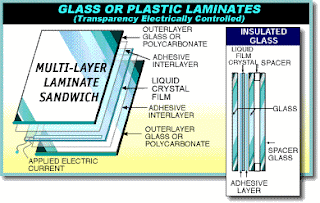The main deliverable of this project is to address situations where privacy, security, and protection from ultraviolet rays is needed. In order to actively regulate the transparency of windows, polymer dispersed liquid crystal (PDLC) films can be placed over the glass to alter the transparency of the window pane. The intensity of incoming light can be minimized by applying a PDLC film, where the crystals are oriented in a way that light cannot pass through. By applying a voltage to the thin film, the degree of transparency can be adjusted so that the glass is most opaque in bright light and more transparent in dim light.
Design Constraints
The extent of this project is limited by a few restraints. First, a ten week period of time limits the preparation and execution of the solution. Second, the development of the project is restricted by the cost of materials, overheads, and salaries due to the budget. Third, access and availability to supplies and resources inhibits the development of the final product. Lastly, the solution will be represented as a prototype because a larger scale is not feasible.
Along with the constraints of time, scale, cost, and availability, there are design constraints. The power must be converted from AC to DC and back to AC for a cleaner signal into the glass, as the potentiometer switch runs more efficiently off alternating current. As the window pane fitted with PDLC will be a prototype, the film must be connected to a battery pack for portability and convenience.
Pre-Existing Solutions
Other solutions that address situations where privacy, security, and energy efficiency are needed include blinds, window treatments, non-adjustable tinted glass, frosted glass, stained glass, and non-transparent materials.
Smart Glass is a laminated product either in glass or polycarbonate that appears opaque, like frosted glass, when non-electrified, and becomes transparent once an electrical current is applied [3].Design Goal
The main goal is to design and construct an electro-optic glass that is sensitive to the intensity of incoming light. By incorporating a light sensor into the circuit, the window will become a type of "smart glass" that limits the amount of light entering a space during the brightest hours of the day. Conversely, the crystals in the PDLC film will orient in a way that allows maximum visibility in the evening. As opposed to an on and off switch controlling the transparency, the polymer dispersed liquid crystal film will be controlled by apparatus resembling a dimmer switch. The amount of voltage that is applied, and therefore the transparency of the glass, will vary based on the intensity of incoming light as detected by a light sensor. The polymer dispersed liquid crystal film will be actively controlled using a program that relates the reading from the light sensor to the amount of voltage applied to the PDLC film.
Project Deliverables
- Pane of Glass
- a light sensor
- a potentiometer switch
- Battery Pack
- DC/AC converter (Power Inverter)
- to create privacy in spaces such as conference rooms, offices, or bathrooms
- increase energy efficiency by regulating temperature in the space

Projected Budget
- PDLC film/Adhesive, SSI Displays, $100 per square foot
- Tempered glass, Polytronix, $130 per square foot
- Cobra CPI 480 DC to AC Power Inverter, Fry's Electronics, $30
- Glass 16in X 20in Model 21620 Home Depot, $4.90
- Rocker Switch Americord 427 $2.05
- 3ft Power Cord Americord $1.43
- 100ft 20ga wire Delcity $6.95

No comments:
Post a Comment